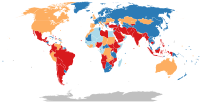
Photo from wikipedia
The differential impact of young age and female gender on transradial access (TRA) outcomes remains to be confirmed. The primary objective was to assess the impact of young age and… Click to show full abstract
The differential impact of young age and female gender on transradial access (TRA) outcomes remains to be confirmed. The primary objective was to assess the impact of young age and female gender on in-hospital net adverse cardiovascular events (NACE). Among 12 346 patients from the Coronary Angiogram Database of South Australia (CADOSA) Registry, the impact of gender; men (transfemoral access [TFA] 1995, TRA 6168) and women (TFA 1249, TRA 2934), and a median split of age, ≤63 years (TFA 1617, TRA 4727) and >63 years (TFA 1627, TRA 4375) were analyzed on in-hospital outcomes by creating 5 separate propensity-matched cohorts (entire cohort, men, women, ≤63 and > 63 years). Net adverse cardiovascular event reduction with TRA was limited to the >63 years old cohort (odds ratio [OR] = 0.56, 95% CI: 0.34-0.93, P = .02) and women (OR = 0.37, 95% CI: 0.18-0.76, P = .007). In both the age groups and genders, TRA was associated with a lower risk of bleeding and all-cause mortality. On multivariate logistic regression, TRA was associated with a significant reduction in NACE, major bleeding, and mortality in the overall cohort. In conclusion, a reduction in bleeding and mortality was noted with TRA in all the subgroups in this observational study.
Journal Title: Angiology
Year Published: 2020
Link to full text (if available)
Share on Social Media: Sign Up to like & get
recommendations!